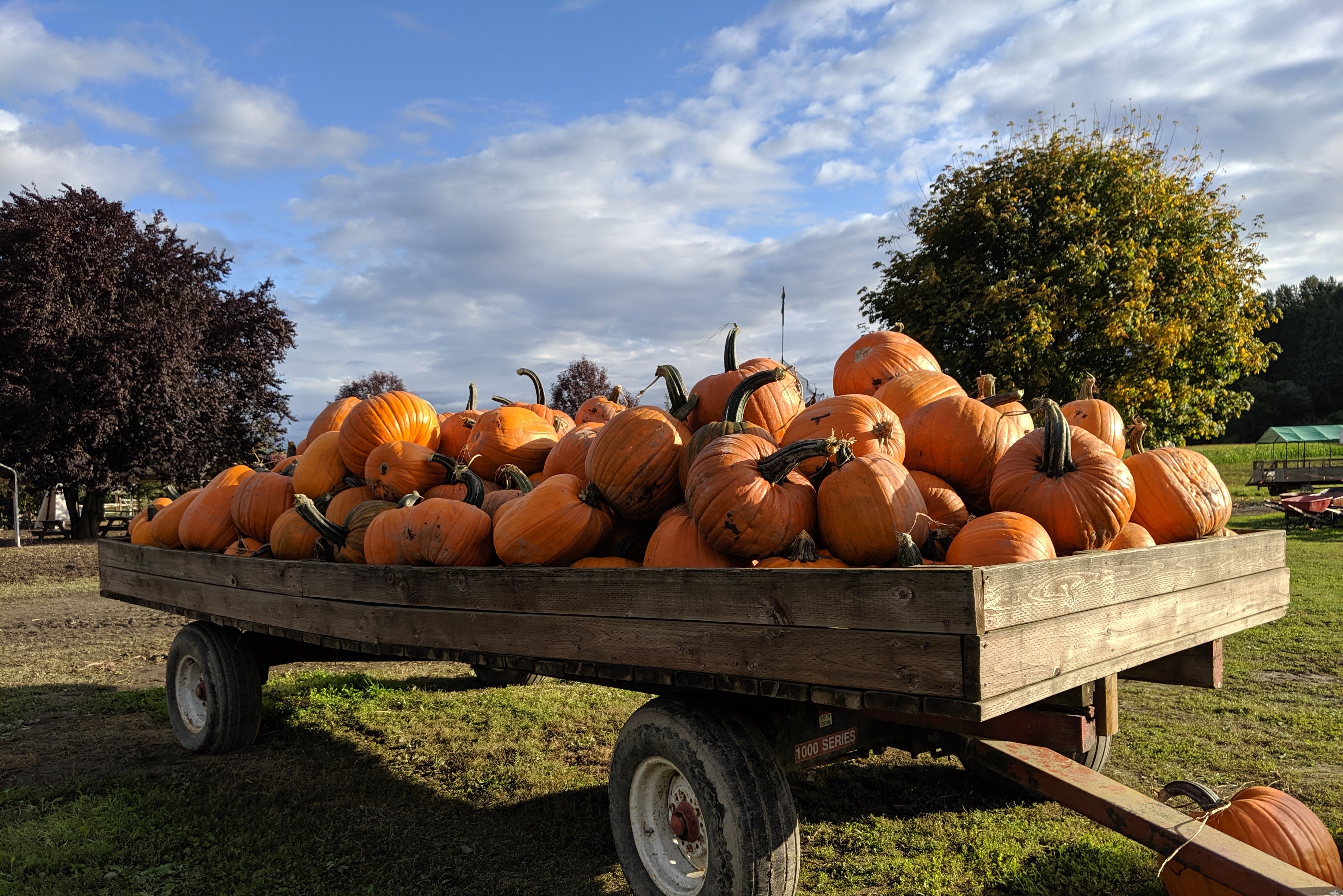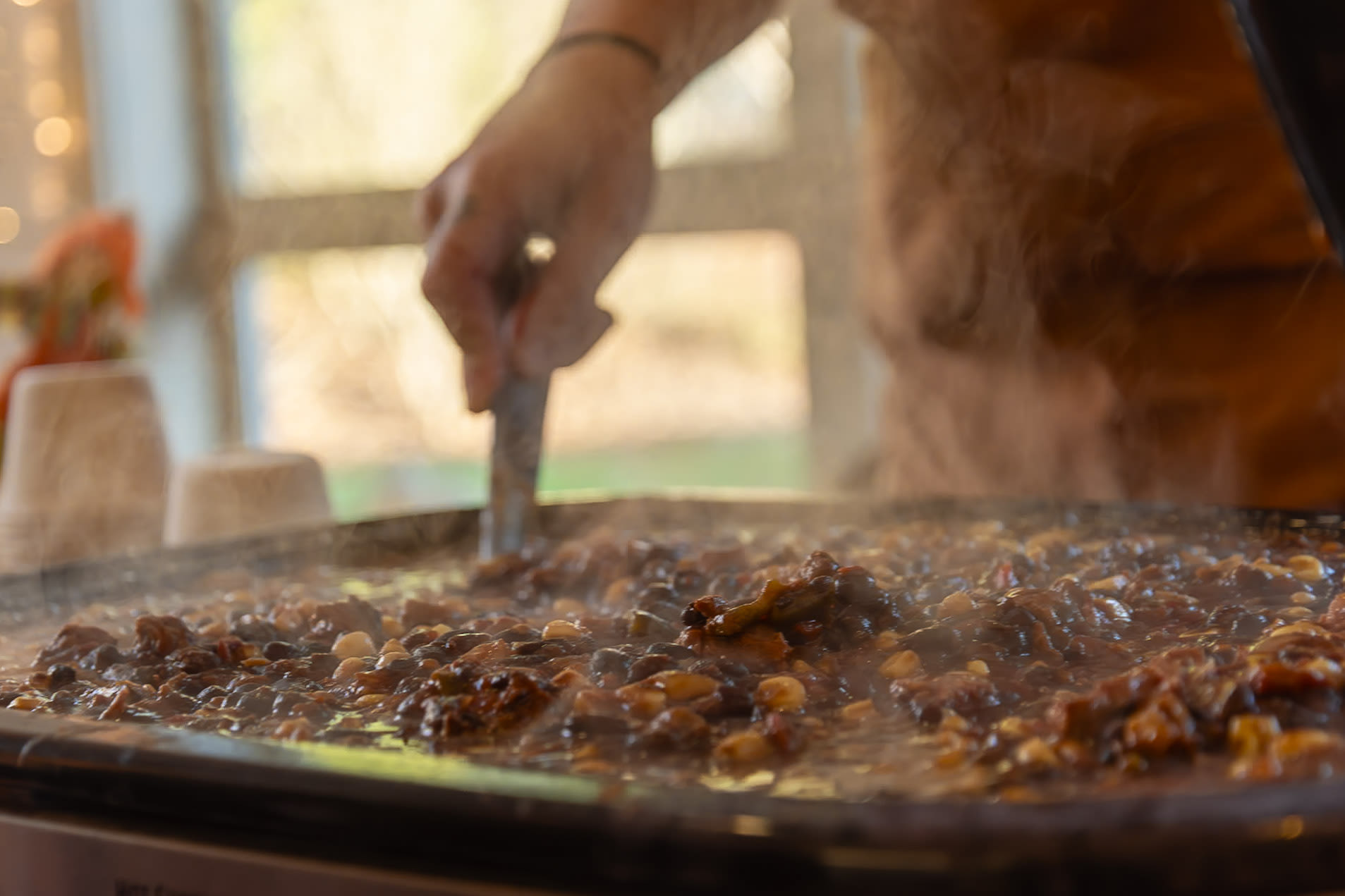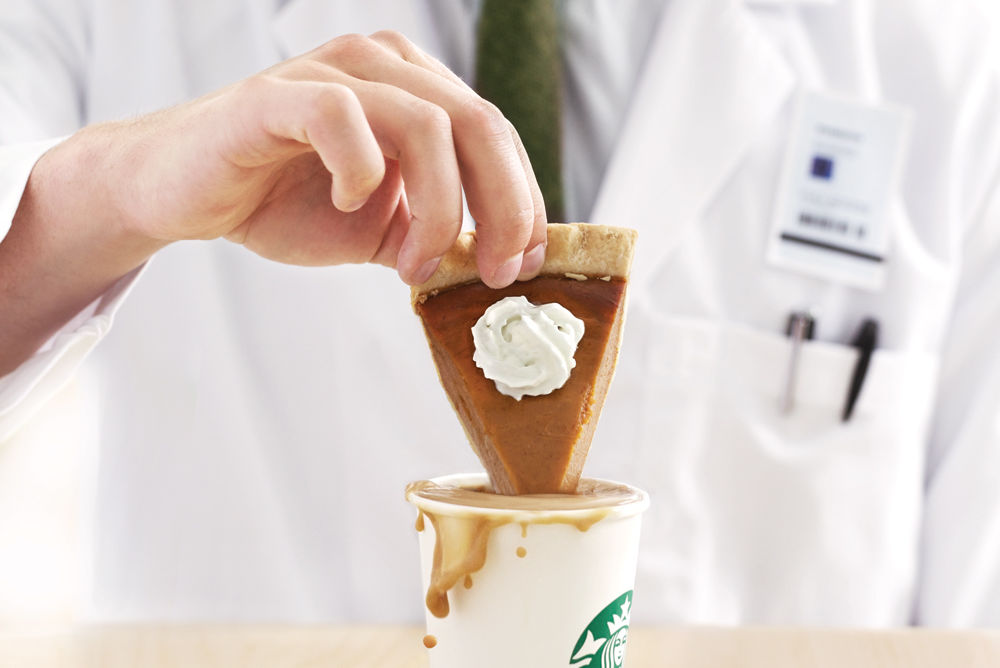
OMFG It's the PSL!
He strode down the narrow beige hallway cradling a pumpkin pie in one arm—an accessory made all the more strange because it was April. And because he ferried this particularly autumnal baked good into a highly secure chamber, one so closely guarded that only he and a scant few others possessed security badges granting access to the room within.
The interior looked like a kitchen crossbred with a high school chemistry lab: An array of glasses and cups awaited experimentation; milk and espresso equipment lined the shelves and filled multiple refrigerators. Outside it was the season for Easter baskets and decorative bunnies, but within this secret space fake leaves rustled on tables and paper turkeys hung on the walls. Someone had draped sweaters over the chairs.
The man—rangy, athletic, thirtysomething—settled in at a table with a handful of colleagues, each with their own homemade or store-bought pumpkin pie before them. A few participants sported lab coats.
There, on this spring day in 2003, under the fluorescent lights of this laboratory at Starbucks headquarters in the heart of SoDo, they picked up their forks and got down to the serious business ahead. Between bites, they discussed the question that brought them here: What does an espresso version of fall’s most seasonal dessert taste like? They forked chunks of filling into their mouths and debated which elements were most appealing with coffee. The pumpkin? The cinnamon? Everyone sipped espresso alongside each forkful; a few even poured shots over their slices to approximate how it might play with pumpkin pie’s texture.
Based on customer surveys and traditional corporate metrics, the bizarre, pumpkin-fueled conclave unfolding here should have never happened. But from it emerged one of the most successful, if sometimes ridiculed, rollouts in Seattle coffee history.

Image: Brandon Hill
Since the pumpkin spice latte’s inception 11 years ago, customers have ordered more than 200 million, each topped with whipped cream and a parting shake of spices. It arrives while the summer sun still beats down hot over most of the country, but a combination of masterful marketing and a fan base with the kind of obsession usually reserved for pop stars has transformed this drink into a national harbinger of fall.
Fans paint tiny Starbucks cups on their nails. They dress their dogs up in latte costumes for Halloween (pug-kin spice latte—get it?). They post online comments like, “Can it be fall now? I am so ready for Pumpkin Spice Latte, pants, warm sweaters & lots of cuddles.” The morning after the first presidential debate of 2012, the nation was talking in nearly equal measures about Obama’s curiously detached performance and a front-page Wall Street Journal article about a temporary shortage of pumpkin spice lattes after an early-season rush.
Plenty of others hate it. Their online comments are more in the vein of “tastes like candle wax” or “How do you make a pumpkin spice latte? Put yoga pants, Ugg boots, a hoodie, an iPhone 5, and a white girl into a blender.” But if you partake in any form of social media whatsoever, it’s nigh impossible to ignore the drink’s return each year. (The Starbucks media team tracks 3,000 tweets a day when the hot beverage reemerges from hibernation, usually around Labor Day.)
Like any larger-than-life figure, the pumpkin spice latte has an origin story. It has also developed a folk hero in Peter Dukes, a lanky former all-metro point guard for the Roosevelt High School basketball team, with long eyelashes, an almost bashful grin, and a sense of humor about his role as the beverage’s unofficial mascot. He even totes a Styrofoam pumpkin to media interviews to set the mood.
Back in early 2003 he was a product manager in the company’s espresso division. In those days Starbucks’ handful of seasonal drinks were clustered around Christmas. The brand new peppermint mocha had performed well, and, company higher-ups told Dukes they wanted a similarly successful drink for the fall season.
His team compiled a list of about 20 potential flavors. Most were some variation of chocolate or caramel, but a conversation about the tastes of fall can’t get too far before someone brings up Thanksgiving’s signature dessert. So Dukes threw the idea of a pumpkin pie latte in the mix. Not that the idea of combining pumpkin pie spices with lattes descended directly from the heavens down to Starbucks headquarters—places like J.L. Hufford Coffee and Tea Company in Lafayette, Indiana, already had one on the menu—but it was definitely unexplored territory in the world of branded espresso drinks.
An online survey invited customers to select the theoretical latte that sounded the most appealing. The results: Starbucks regulars overwhelmingly preferred ushering in autumn with those familiar chocolate or caramel flavors. The pumpkin pie latte fell flat in the survey.
Well, “fell flat” is a little harsh. “Near the bottom middle,” Dukes recalls. It should have died there. But something about the idea stirred his imagination. He couldn’t let it go.
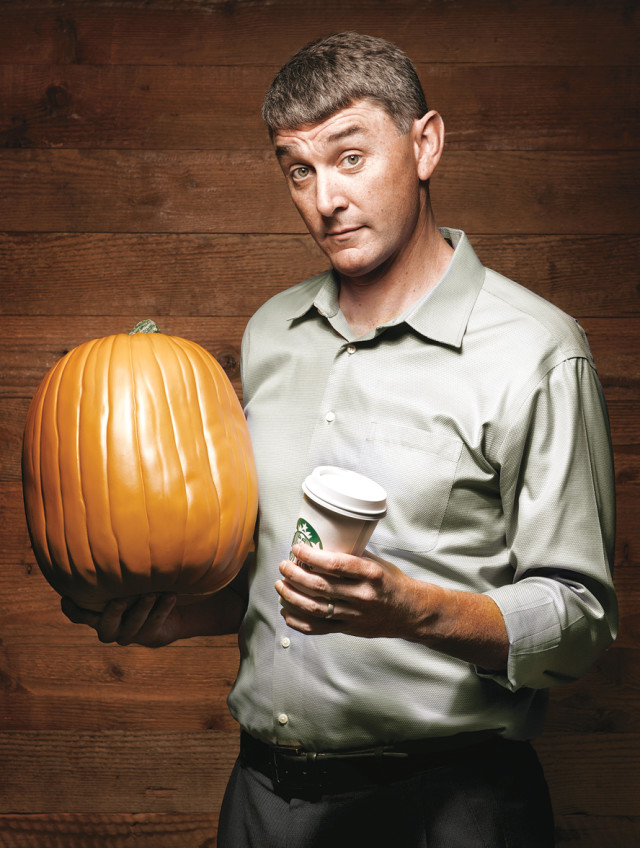
Image: Brandon Hill
At 44, Dukes is old enough—barely—to have grown up with Starbucks. As a kid his mom would take him shopping at the QFC in University Village and give him the decidedly adult responsibility of selecting the coffee, plus a piece of chocolate for himself. He left Seattle to study economics (and play basketball) at Stanford, then went on to work in accounting before an MBA recast his path. He arrived at Starbucks in 2001. In the spring of 2003, he found himself pondering pumpkin as he prowled other coffee shops and paced the aisles of local grocery stores in the name of research.
The orange gourd is so tied to our cultural identity that Americans of all backgrounds, in all climates, feel compelled to go pick them in the patch, attend festivals in their honor, or set one on the front porch for an entire month, even though we seldom actually eat it. When you get down to it, the flavor is pretty mild.
Dukes noted a subtle distinction, but an important one: The blend of spices that go into a pumpkin pie—nutmeg, cinnamon, a bit of clove—is deeply familiar, almost primal to consumers, but new ground for flavored drinks…or any other flavored product. Not only do the smell and taste of those spices evoke all the nostalgia that goes with the season, Dukes realized, they answered the questions raised back in the liquid lab: “The spice is important because it brings out the pumpkin and the espresso.”
Now he had to select which flavors made it to the next step—with his boss’s approval. The world of brand management is a jargon-filled one, and bench top is the term for what happens next. Product managers like Dukes join forces with the research and development team and prepare actual steaming, frothy prototypes of each drink. Mocking up multiple versions of 20 seasonal lattes would be prohibitively expensive, so it was Dukes’s job to put forward four contenders from that original list—four drinks worthy of analysis, scrutiny, and tasting over and over again.
Three of the drinks he presented to a team headed by Michelle Gass, then the vice president of beverages, were unimpeachably logical—they ranked at the top of the customer survey. There was a chocolate-caramel concoction, a latte with orange flavoring and spices, and another dubbed the cinnamon streusel latte that would later be released as the cinnamon dolce latte. Then there was his fourth and final recommendation: that drink with pumpkin pie flavoring.
Gass was skeptical. Those mediocre customer survey results didn’t exactly telegraph “wildly successful fall beverage.”
Her approval was key, not only because of her title, but because she was a rising star at Starbucks. The former chemical engineering major was just 35 at the time, two years older than Dukes, but had already made a name for herself as the marketing manager for Frappuccinos, expanding the line beyond the original coffee and mocha flavors and taking it from a tiny slice of Starbucks’ profits to more than $2 billion. (It was her idea to promote the Frapp as an afternoon indulgence and to add the almost hedonistic cloud of whipped cream.)
But Dukes stood firm against his boss’s push back. “Trust me,” he told her. “Let us play with it. I’ve seen what’s out there in the market, and there’s nothing like it.”
What followed was a three-month odyssey of mating pumpkin with spice. The R&D team targeted four possibilities for the drink—high pumpkin, high spice, low pumpkin, low spice—and versions with high and low levels of both components. They tested. They refined. Joined along the way by a few others, the same gang that sampled pumpkin pies beneath paper turkey decorations in the liquid lab gathered again two or three times a week, tasting their way through these prototype versions. They jotted notes on sheets and went around the circle sharing feedback on each drink, book club style. “I’ve tasted a lot of pumpkin spice beverages,” says Dukes. “You just keep narrowing down and narrowing down.”
The pumpkin spice cabal decided the flavoring should be a sauce, not the typical flavored syrup. That extra viscosity helped mimic the proper heft of a mouthful of pie. Ultimately the version with high levels of both pumpkin and spice won consensus.
The next question: what to call the thing. “Initially we were being asked to come up with a name that matches the season,” Dukes recalls. His team batted around the idea of “fall harvest latte,” a name that at best didn’t quite explain the drink and at worst connoted sipping on a hay bale. They settled on pumpkin spice latte, a simple name that communicated all the happy-fuzzy feelings associated with pumpkin but reflected the spices’ prominence.
Early tests at 100 stores in Vancouver and Washington, DC, in the fall of 2003 portended customers might actually like this wild card of a drink. “You just looked at the sales results and you knew,” Dukes remembers. “It clearly separated itself from any other beverages we had tested at that point in the market.”
The company’s 10-year PSL anniversary hoopla happened last year, oddly enough, but the pumpkin spice latte made its nationwide debut one decade ago this September. The following month, October 2004, company sales spiked 11 percent compared with the previous year, thanks in large part to the new hit drink. But once technology—particularly the nascent quivers of social media—caught up, it would become something even bigger.
“Every year I’ll drink at least one to commemorate that it’s fall,” Melody Overton said of the pumpkin spice latte on a recent evening at the Starbucks on Olive Way. You might say that Overton’s a fan of Starbucks. An attorney in Pioneer Square by day, she keeps a personal blog and self-published a book, both dedicated to the coffee company’s general doings and her various Starbucks--related adventures—like road tripping to Sacramento to sample test drinks at locations there. She refers to her encounters with Howard (Schultz, the CEO) and Cliff (Burrows, the head of Starbucks in both North and South America) with mononymous awe and even sends Howard a birthday email every year. She’d like to convey those same wishes to Cliff, she just doesn’t know his birthday.
Despite her annual pumpkin spice assignation, though, and despite having a poster of the drink hanging in her office, “I’m not actually a huge pumpkin spice latte fan,” Overton confesses. “It’s a little bit sweet for me.”
Laila Ghambari knows what she means. The director of coffee at the local chainlets of Cherry Street coffeehouses (her dad’s the founder) and winner of the 2014 United States Barista Championship, Ghambari is not ashamed to admit that she enjoys the occasional hit of pumpkin spice.
The flavor has now infiltrated coffee shops everywhere. In 2012 Cherry Street started making its own sauce, one that ratchets down the sweetness, amps up the spice, and—unlike the original—contains actual pureed pumpkin. (During a three-month window last year, Cherry Street baristas went through 24 gallons of the house pumpkin spice syrup and served up roughly 3,500 of the seasonal lattes.)
America’s affection for specialty drinks stems from its collective history of drinking really bad coffee, Ghambari says. The sort that involves a screw-topped tub of granules and a little plastic scoop. “It doesn’t taste good, so you put cream and sugar in it. Now, even if the coffee doesn’t taste bad, people assume it’s going to taste that way. They automatically order something with syrup in it”—the coffee equivalent of salting food before taking a bite.
I finally drank one myself on a chilled afternoon last fall at the Starbucks on Pier 55, in the shadow of the crumbling Alaskan Way Viaduct. When the barista called my name and plunked my order on the counter, the only thing distinguishing it from drinks that don’t have their own official Twitter handles is that scrawl of “PSL” in black Sharpie on the side of the cup. (The company trademarked the acronym in 2013.) A strong, sweet aroma wafted out of the tiny hole in the lid.
The formula hasn’t changed since those first days in the lab (“We’d have a revolt,” says Dukes of the PSL fan base). The version that emerged from those clandestine meetings bears more resemblance to a liquefied glazed doughnut than a piece of pumpkin pie. One flavor that’s conspicuously absent is the sharp rap of espresso. It’s in there, though, just lurking beneath the sweetness. Perhaps even more conspicuous: the lack of any discernible pumpkin. There is pumpkin in the formula. Or, more precisely, pumpkin flavor. But the spices assert themselves utterly over the more delicate gourd. If this were a piece of art, the pumpkin would be formed by negative space.
While chalkboard art in Starbucks stores focuses on the pumpkins, those spices—along with that age-old trick of making something a limited-time commodity (cough, McDonald’s Shamrock Shake)—are key to the mania. At least that’s the theory posited by Carolyn Ross, an associate professor at the school of food science at Washington State University. “People agree it smells nice across cultures,” she says of the nutmeg, cinnamon, and clove blend. “I once had a pumpkin spice latte not from Starbucks that was pumpkin-heavy, and it was awful.”
But what really fuels the PSL craze? Adroit marketing and social media. Each year brings an increasingly elaborate rollout plan, involving hashtags and secret codes that “unlock” the PSL at a particular store and Facebook contests where fans vie to have the latte land in their city a week earlier than the national debut. To follow #PSL on Twitter or Instagram this time of year is to be flooded with images of those Starbucks cups, brandished, hoisted, or artfully arranged to showcase that familiar acronym scrawled on the side in black. And then, of course, there are the commercials: the one with the overzealous PSL fan air drumming with a pair of green venti straws; or the series featuring a fully staged—and completely fake—Pumpkin Spice Days festival in a small, bucolic town, complete with cinnamon-stick-twirling contests and a Miss Pumpkin Spice pageant.
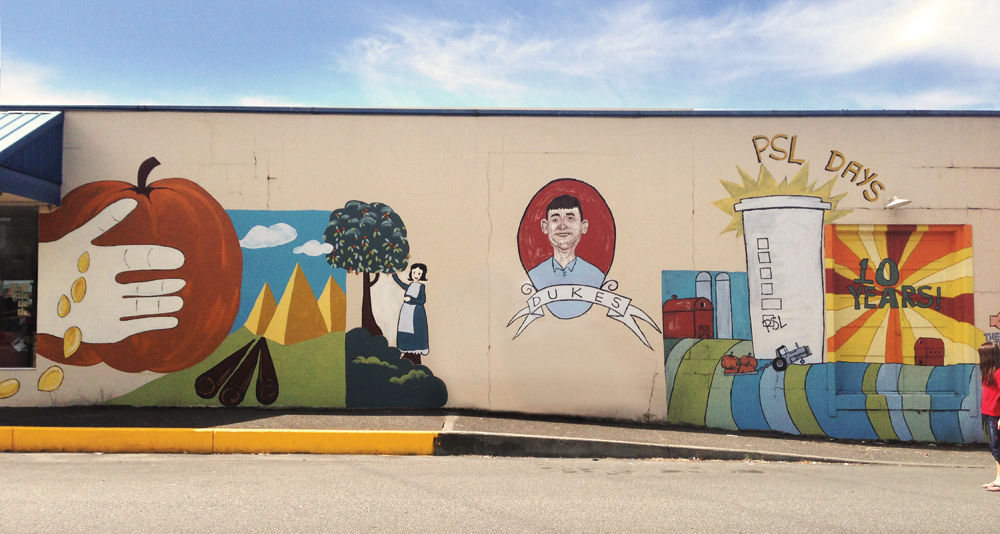
Peter Dukes the man long ago moved on to new projects within the company. But Peter Dukes the homage is 60 miles north of Starbucks HQ, in Skagit County. Just off Route 20, in the old downtown strip of Burlington, population 8,400, dwells a five-foot-tall illustration of Dukes, a deliberately rustic rendering of the sort of portrait that might gaze out from the pages of a high school history textbook.
This oddball tribute is left over from the most recent round of Pumpkin Spice Days commercials, filmed in the area in 2013 for the drink’s 10th anniversary campaign. But the staffers at a nearby Starbucks, three miles north, were puzzled when I asked where it was. “I should know,” confessed the motherly woman who took my order. “My daughter was in that commercial.” The kindly ladies at the town visitor’s center, however, received my query as if it were a totally normal one, spun me around, and pointed me toward the sidewall of the DeCamp and Stradford furniture store directly across the street.
Dukes is depicted from the shoulders up, wearing a blue polo shirt. His name is emblazoned on a white banner splayed across his chest. It’s an exaggerated likeness; the real Dukes looks distinguished and slightly outdoorsy. Here the artist gave him a less-than-flattering overbite and sort of a Dumb and Dumber–meets–business casual haircut. “They emphasized that this was supposed to be a caricature,” he had told me. (He once stopped to pay it a visit and snap a few photos while driving his daughters to summer camp in Bellingham.)
Just around the corner from Dukes’s smiling likeness, Burlington’s old main street still bears the false fronts, sturdy awnings, and backdrop of sloping fir trees that recall its start as a logging town. Though the PSL festival in the commercials was fictional, the town does celebrate Berry Dairy days every June. It’s a true-to-life version of the agrarian American ideals the humble pumpkin represents.
What was created in a lab has taken on a life of its own and become a frothy microcosm of how contradictory those ideals can be these days. The pumpkin spice latte is loved and hated. Artificial but genuine. Manufactured by canny marketing, yet legitimately, ardently adored. We have once again become a population accustomed to consuming seasonally, be it the first rhubarb of spring, summertime berries, or a sauce engineered to summon fall from inside a corrugated cardboard sleeve while the summer sun still shines overhead.
